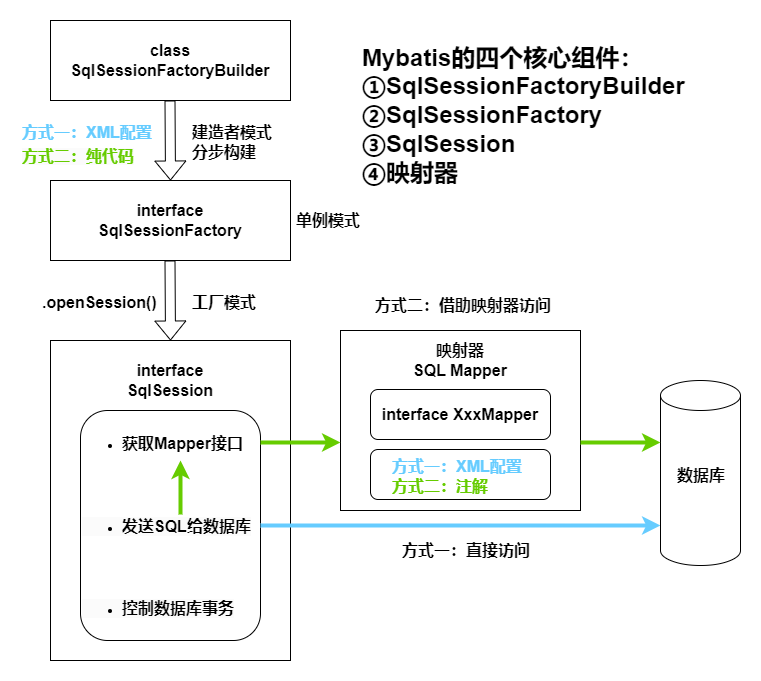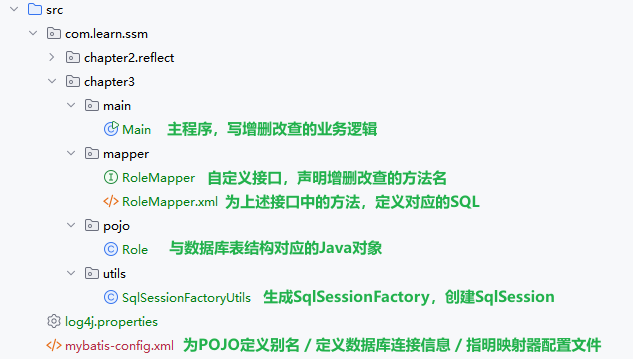Mybatis 核心组件
核心组件
- SqlSessionFactoryBuilder:根据XML配置或者纯代码的方式来生成SqlSessionFactory,采用建造者模式来分步构建,生成的SqlSessionFactory是单例模式。
- SqlSessionFactory:采用工厂模式通过openSession方法生成SqlSession。
- SqlSession:
- 获取Mapper接口
- 发送SQL给数据库
- 控制数据库事务
- SQL Mapper(映射器):由一个自定义Mapper接口 + XML或注解两部分构成。前者声明方法,后者给出方法对应的SQL。
映射器里的Mapper只是个接口,而非实现类,接口不是不能运行吗?那Mapper接口是如何发挥作用的?
MyBatis 利用了 JDK 的动态代理机制,为每个 Mapper 接口生成了一个代理对象,方法调用时会自动执行与之绑定的 SQL。

生命周期
| 对象 | 生命周期 | 线程安全 | 使用建议 |
|---|---|---|---|
| SqlSessionFactoryBuilder | 很短 | ❌ | 用一次就丢,不要共享 |
| SqlSessionFactory | 很长(单例) | ✅ | 应用中唯一实例,全局共享 |
| SqlSession | 很短 | ❌ | 每次数据库操作创建一个,用完关闭 |
| Mapper | 很短 | ❌ | 每次从 SqlSession 获取,不跨线程 |
如果是在 Spring 项目中,这些对象的生命周期和管理会由 Spring 接管,
SqlSession可以由 Spring 自动注入并管理事务。
实例
1.准备jar包
- mybatis-3.4.1.jar
- mysql-connector-j-8.0.33.jar
- log4j-1.2.17.jar
2.文件结构

POJO
package com.learn.ssm.chapter3.pojo;
public class Role {
private Long id;
private String roleName;
private String note;
//如果你没有写任何构造函数,Java 会自动生成一个无参构造函数。
//public Role(){}
public Long getId() {
return id;
}
public void setId(Long id) {
this.id = id;
}
public String getRoleName() {
return roleName;
}
public void setRoleName(String roleName) {
this.roleName = roleName;
}
public String getNote() {
return note;
}
public void setNote(String note) {
this.note = note;
}
}
映射器Mapper接口
package com.learn.ssm.chapter3.mapper;
import com.learn.ssm.chapter3.pojo.Role;
import java.util.List;
public interface RoleMapper {
public int insertRole(Role role);
public int deleteRole(Long id);
public int updateRole(Role role);
public Role getRole(Long id);
public List<Role> findRoles(String roleName);
}
映射器配置(XML)
<?xml version="1.0" encoding="UTF-8" ?>
<!DOCTYPE mapper PUBLIC "-//mybatis.org//DTD Mapper 3.0//EN"
"http://mybatis.org/dtd/mybatis-3-mapper.dtd">
<mapper namespace="com.learn.ssm.chapter3.mapper.RoleMapper">
<insert id="insertRole" parameterType="role">
insert into t_role(id, role_name, note)
values(#{id}, #{roleName}, #{note})
</insert>
<delete id="deleteRole" parameterType="long">
delete from t_role where id = #{id}
</delete>
<update id="updateRole" parameterType="role">
update t_role set role_name = #{roleName}, note = #{note}
where id = #{id}
</update>
<select id="getRole" parameterType="long" resultType="role">
select id, role_name as roleName, note from t_role where id = #{id}
</select>
<select id="findRoles" parameterType="string" resultType="role">
select id, role_name as roleName, note from t_role
where role_name like concat('%', #{roleName}, '%')
</select>
</mapper>
mybatis-config.xml
<?xml version="1.0" encoding="UTF-8" ?>
<!DOCTYPE configuration PUBLIC "-//mybatis.org//DTD Config 3.0//EN"
"http://mybatis.org/dtd/mybatis-3-config.dtd">
<configuration>
<typeAliases><!-- 别名 -->
<typeAlias alias="role" type="com.learn.ssm.chapter3.pojo.Role"/>
</typeAliases>
<!-- 数据库环境 -->
<environments default="development">
<environment id="development">
<transactionManager type="JDBC"/>
<dataSource type="POOLED">
<property name="driver" value="com.mysql.cj.jdbc.Driver"/>
<property name="url" value="jdbc:mysql://localhost:3306/ssm"/>
<property name="username" value="root"/>
<property name="password" value="123456"/>
</dataSource>
</environment>
</environments>
<!-- 映射文件 -->
<mappers>
<mapper resource="com/learn/ssm/chapter3/mapper/RoleMapper.xml"/>
</mappers>
</configuration>
构建SqlSessionFactory与SqlSession
package com.learn.ssm.chapter3.utils;
import org.apache.ibatis.io.Resources;
import org.apache.ibatis.session.SqlSession;
import org.apache.ibatis.session.SqlSessionFactory;
import org.apache.ibatis.session.SqlSessionFactoryBuilder;
import java.io.IOException;
import java.io.InputStream;
public class SqlSessionFactoryUtils {
private final static Class<SqlSessionFactoryUtils> LOCK = SqlSessionFactoryUtils.class;
// 构造函数
private SqlSessionFactoryUtils(){}
// 单例模式
private static SqlSessionFactory sqlSessionFactory = null;
public static SqlSessionFactory getSqlSessionFactory() {
synchronized (LOCK) {
if(sqlSessionFactory != null) {
return sqlSessionFactory;
}
// XML配置方式 实例化SqlSessionFactory
String resource = "mybatis-config.xml";
InputStream inputStream;
try {
inputStream = Resources.getResourceAsStream(resource);
sqlSessionFactory = new SqlSessionFactoryBuilder().build(inputStream);
} catch (IOException e) {
e.printStackTrace();
}
}
return sqlSessionFactory;
}
public static SqlSession openSqlSession() {
if(sqlSessionFactory == null) {
getSqlSessionFactory();
}
return sqlSessionFactory.openSession();
}
}
主程序
package com.learn.ssm.chapter3.main;
import com.learn.ssm.chapter3.mapper.RoleMapper;
import com.learn.ssm.chapter3.pojo.Role;
import com.learn.ssm.chapter3.utils.SqlSessionFactoryUtils;
import org.apache.ibatis.session.SqlSession;
import org.apache.log4j.Logger;
import java.util.List;
public class Main {
public static void main(String[] args) {
testRoleMapper();
}
private static void testRoleMapper() {
Logger logger = Logger.getLogger(Main.class);
SqlSession sqlSession = null;
try {
sqlSession = SqlSessionFactoryUtils.openSqlSession();
RoleMapper roleMapper = sqlSession.getMapper(RoleMapper.class);
Role role = new Role();
role.setId(1L);
role.setRoleName("Admin");
role.setNote("System role");
int num = roleMapper.insertRole(role);
logger.info(num);//1
Role role1 = roleMapper.getRole(1L);
logger.info(role1);//com.learn.ssm.chapter3.pojo.Role@551a20d6
role1.setRoleName("Administrator");
num = roleMapper.updateRole(role1);
logger.info(num);//1
Role role2 = new Role();
role2.setId(2L);
role2.setRoleName("Visitor");
role2.setNote("Unregistered");
num = roleMapper.insertRole(role2);
logger.info(num);//1
List<Role> roles = roleMapper.findRoles("i");
logger.info(roles);
// [com.learn.ssm.chapter3.pojo.Role@7a11c4c7, com.learn.ssm.chapter3.pojo.Role@4cc547a]
//提交事务
sqlSession.commit();
} catch (Exception e) {
if(sqlSession != null) {
sqlSession.rollback();
}
e.printStackTrace();
} finally {
if (sqlSession != null) {
sqlSession.close();
}
}
}
}
3.输出
DEBUG 2025-04-23 11:13:00,807 org.apache.ibatis.logging.LogFactory: Logging initialized using 'class org.apache.ibatis.logging.log4j.Log4jImpl' adapter.
DEBUG 2025-04-23 11:13:00,903 org.apache.ibatis.datasource.pooled.PooledDataSource: PooledDataSource forcefully closed/removed all connections.
DEBUG 2025-04-23 11:13:00,903 org.apache.ibatis.datasource.pooled.PooledDataSource: PooledDataSource forcefully closed/removed all connections.
DEBUG 2025-04-23 11:13:00,903 org.apache.ibatis.datasource.pooled.PooledDataSource: PooledDataSource forcefully closed/removed all connections.
DEBUG 2025-04-23 11:13:00,903 org.apache.ibatis.datasource.pooled.PooledDataSource: PooledDataSource forcefully closed/removed all connections.
DEBUG 2025-04-23 11:13:00,962 org.apache.ibatis.transaction.jdbc.JdbcTransaction: Opening JDBC Connection
DEBUG 2025-04-23 11:13:01,557 org.apache.ibatis.datasource.pooled.PooledDataSource: Created connection 50503805.
DEBUG 2025-04-23 11:13:01,557 org.apache.ibatis.transaction.jdbc.JdbcTransaction: Setting autocommit to false on JDBC Connection [com.mysql.cj.jdbc.ConnectionImpl@302a07d]
DEBUG 2025-04-23 11:13:01,559 org.apache.ibatis.logging.jdbc.BaseJdbcLogger: ==> Preparing: insert into t_role(id, role_name, note) values(?, ?, ?)
DEBUG 2025-04-23 11:13:01,581 org.apache.ibatis.logging.jdbc.BaseJdbcLogger: ==> Parameters: 1(Long), Admin(String), System role(String)
DEBUG 2025-04-23 11:13:01,584 org.apache.ibatis.logging.jdbc.BaseJdbcLogger: <== Updates: 1
INFO 2025-04-23 11:13:01,584 com.learn.ssm.chapter3.main.Main: 1
DEBUG 2025-04-23 11:13:01,585 org.apache.ibatis.logging.jdbc.BaseJdbcLogger: ==> Preparing: select id, role_name as roleName, note from t_role where id = ?
DEBUG 2025-04-23 11:13:01,586 org.apache.ibatis.logging.jdbc.BaseJdbcLogger: ==> Parameters: 1(Long)
DEBUG 2025-04-23 11:13:01,601 org.apache.ibatis.logging.jdbc.BaseJdbcLogger: <== Total: 1
INFO 2025-04-23 11:13:01,602 com.learn.ssm.chapter3.main.Main: com.learn.ssm.chapter3.pojo.Role@5644dc81
DEBUG 2025-04-23 11:13:01,602 org.apache.ibatis.logging.jdbc.BaseJdbcLogger: ==> Preparing: update t_role set role_name = ?, note = ? where id = ?
DEBUG 2025-04-23 11:13:01,603 org.apache.ibatis.logging.jdbc.BaseJdbcLogger: ==> Parameters: Administrator(String), System role(String), 1(Long)
DEBUG 2025-04-23 11:13:01,604 org.apache.ibatis.logging.jdbc.BaseJdbcLogger: <== Updates: 1
INFO 2025-04-23 11:13:01,604 com.learn.ssm.chapter3.main.Main: 1
DEBUG 2025-04-23 11:13:01,604 org.apache.ibatis.logging.jdbc.BaseJdbcLogger: ==> Preparing: insert into t_role(id, role_name, note) values(?, ?, ?)
DEBUG 2025-04-23 11:13:01,604 org.apache.ibatis.logging.jdbc.BaseJdbcLogger: ==> Parameters: 2(Long), Visitor(String), Unregistered(String)
DEBUG 2025-04-23 11:13:01,605 org.apache.ibatis.logging.jdbc.BaseJdbcLogger: <== Updates: 1
INFO 2025-04-23 11:13:01,605 com.learn.ssm.chapter3.main.Main: 1
DEBUG 2025-04-23 11:13:01,605 org.apache.ibatis.logging.jdbc.BaseJdbcLogger: ==> Preparing: select id, role_name as roleName, note from t_role where role_name like concat('%', ?, '%')
DEBUG 2025-04-23 11:13:01,605 org.apache.ibatis.logging.jdbc.BaseJdbcLogger: ==> Parameters: i(String)
DEBUG 2025-04-23 11:13:01,607 org.apache.ibatis.logging.jdbc.BaseJdbcLogger: <== Total: 2
INFO 2025-04-23 11:13:01,607 com.learn.ssm.chapter3.main.Main: [com.learn.ssm.chapter3.pojo.Role@3381b4fc, com.learn.ssm.chapter3.pojo.Role@6bea52d4]
DEBUG 2025-04-23 11:13:01,607 org.apache.ibatis.transaction.jdbc.JdbcTransaction: Committing JDBC Connection [com.mysql.cj.jdbc.ConnectionImpl@302a07d]
DEBUG 2025-04-23 11:13:01,693 org.apache.ibatis.transaction.jdbc.JdbcTransaction: Resetting autocommit to true on JDBC Connection [com.mysql.cj.jdbc.ConnectionImpl@302a07d]
DEBUG 2025-04-23 11:13:01,693 org.apache.ibatis.transaction.jdbc.JdbcTransaction: Closing JDBC Connection [com.mysql.cj.jdbc.ConnectionImpl@302a07d]
DEBUG 2025-04-23 11:13:01,693 org.apache.ibatis.datasource.pooled.PooledDataSource: Returned connection 50503805 to pool.
其他补充
纯代码创建SqlSessionFactory
public static SqlSessionFactory getSqlSessionFactory2() {
synchronized (LOCK) {
// 数据库连接池信息
PooledDataSource dataSource = new PooledDataSource();
dataSource.setDriver("com.mysql.jdbc.Driver");
dataSource.setUsername("root");
dataSource.setPassword("123456");
dataSource.setUrl("jdbc:mysql://localhost:3306/chapter3");
dataSource.setDefaultAutoCommit(false);
// 采用MyBatis的JDBC事务方式
TransactionFactory transactionFactory = new JdbcTransactionFactory();
Environment environment = new Environment("development", transactionFactory, dataSource);
// 创建Configuration对象
Configuration configuration = new Configuration(environment);
// 注册一个MyBatis上下文别名
configuration.getTypeAliasRegistry().registerAlias("role", Role.class);
// 加入一个映射器
configuration.addMapper(RoleMapper.class);
configuration.addMapper(RoleMapper2.class);
// 使用SqlSessionFactoryBuilder构建SqlSessionFactory
sqlSessionFactory = new SqlSessionFactoryBuilder().build(configuration);
return sqlSessionFactory;
}
}
代码冗长,如果发生系统修改,那么有可能需要重新编译代码才能继续。
Mapper+注解实现映射器
package com.learn.ssm.chapter3.mapper;
import org.apache.ibatis.annotations.Select;
import com.learn.ssm.chapter3.pojo.Role;
public interface RoleMapper2 {
@Select("select id, role_name as roleName, note from t_role where id=#{id}")
public Role getRole(Long id);
}
效果等同于Mapper+XML实现映射器,如果两种方式都用了,那么XML方式会覆盖掉注解方式,即XML方式优先级更高。
在实际业务中,SQL的复杂度很高,采用注解方式会将大量的SQL放入Java代码中,代码可读性会下降,如果再涉及动态SQL,注解就更复杂了,不利于后期维护和修改。
此外,XML可以相互引入,但注解不行。所以XML方式用的较多。
SqlSession直接发送SQL
Role role = (Role)sqlSession.
selectOne("com.learn.ssm.chapter3.mapper.RoleMapper.getRole", 1L);
selectOne 方法表示使用查询并且只返回一个对象,而参数则是一个String对象和一个Object对象。这里是一个long 参数,long 参数是它的主键。
String 对象是由一个命名空间加上 SQL id 组合而成的,它完全定位了一条SQL,这样 MyBatis 就会找到对应的SQL 。如果在 MyBatis 中只有一个 id为getRole的SQL,那么上述代码可以简写为:
Role role = (Role)sqlSession.selectOne("getRole", 1L);
这是Mybatis的前身iBatis所留下的方式。现在通常都是先获取Mapper接口,由Mapper发送SQL。
